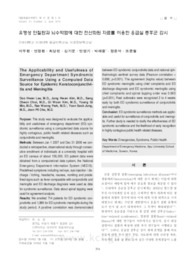

PARTNER
검증된 파트너 제휴사 자료
유행성 안질환과 뇌수막염에 대한 전산화된 자료를 이용한 응급실 증후군 감시 (The Applicability and Usefulness of Emergency Department Syndromic Surveillance Using a Computed Data Source for Epidemic Keratoconjunctivitis and Meningitis)
8 페이지
최초등록일 2025.04.01
최종저작일
2010.06

-
미리보기
서지정보
· 발행기관 : 대한응급의학회
· 수록지 정보 : 대한응급의학회지 / 21권 / 3호 / 374 ~ 381페이지
· 저자명 : 이두환, 안정환, 김기운, 박래웅, 정윤석, 조준필, 최상천, 민영기
초록
Purpose: This study was designed to evaluate the applicability and usefulness of emergency department (ED) syndromic surveillance using a computerized data source for highly contagious, public health related diseases such as conjunctivitis and meningitis.
Methods: Between Jan 1 2007 and Dec 31 2008 we conducted a retrospective, observational study through consecutive enrollment of individuals at a university hospital with an ED census of about 156,000. ED patient data were obtained from a computerized data system, the National Emergency Department Information System (NEDIS).
Predefined symptoms including red eye, eye injection / discharge / itching, headache, nausea, vomiting and predefined signs such as fever comparable with conjunctivitis and meningitis and ED discharge diagnosis were used as data for syndromic surveillance. Data about spinal tapping were used for agreement analysis.
Results: We enrolled 714 patients for ED syndromic conjunctivitis and 1,889 for ED syndromic meningitis during the study period. A positive correlation was demonstrated between ED syndromic conjunctivitis data and national ophthalmologic sentinel survey data (Pearson correlation =0.696; p<0.001). The agreement (kapha value) between ED syndromic meningitis using chief complaints and ED discharge diagnosis and ED syndromic meningitis using chief complaints and spinal tapping order was 0.665(p<0.001). Real outbreaks were recognized 2 to 4 weeks early by both ED syndromic surveillance of conjunctivitis and meningitis.
Conclusion: ED syndromic surveillance methods are applicable and useful for surveillance of conjunctivitis and meningitis.
Further study is needed to clarify the effectiveness of ED syndromic surveillance and the likelihood of early recognition in highly contagious public health related diseases.영어초록
Purpose: This study was designed to evaluate the applicability and usefulness of emergency department (ED) syndromic surveillance using a computerized data source for highly contagious, public health related diseases such as conjunctivitis and meningitis.
Methods: Between Jan 1 2007 and Dec 31 2008 we conducted a retrospective, observational study through consecutive enrollment of individuals at a university hospital with an ED census of about 156,000. ED patient data were obtained from a computerized data system, the National Emergency Department Information System (NEDIS).
Predefined symptoms including red eye, eye injection / discharge / itching, headache, nausea, vomiting and predefined signs such as fever comparable with conjunctivitis and meningitis and ED discharge diagnosis were used as data for syndromic surveillance. Data about spinal tapping were used for agreement analysis.
Results: We enrolled 714 patients for ED syndromic conjunctivitis and 1,889 for ED syndromic meningitis during the study period. A positive correlation was demonstrated between ED syndromic conjunctivitis data and national ophthalmologic sentinel survey data (Pearson correlation =0.696; p<0.001). The agreement (kapha value) between ED syndromic meningitis using chief complaints and ED discharge diagnosis and ED syndromic meningitis using chief complaints and spinal tapping order was 0.665(p<0.001). Real outbreaks were recognized 2 to 4 weeks early by both ED syndromic surveillance of conjunctivitis and meningitis.
Conclusion: ED syndromic surveillance methods are applicable and useful for surveillance of conjunctivitis and meningitis.
Further study is needed to clarify the effectiveness of ED syndromic surveillance and the likelihood of early recognition in highly contagious public health related diseases.참고자료
· 없음태그
-
자주묻는질문의 답변을 확인해 주세요

꼭 알아주세요
-
자료의 정보 및 내용의 진실성에 대하여 해피캠퍼스는 보증하지 않으며, 해당 정보 및 게시물 저작권과 기타 법적 책임은 자료 등록자에게 있습니다.
자료 및 게시물 내용의 불법적 이용, 무단 전재∙배포는 금지되어 있습니다.
저작권침해, 명예훼손 등 분쟁 요소 발견 시 고객센터의 저작권침해 신고센터를 이용해 주시기 바랍니다. -
해피캠퍼스는 구매자와 판매자 모두가 만족하는 서비스가 되도록 노력하고 있으며, 아래의 4가지 자료환불 조건을 꼭 확인해주시기 바랍니다.
파일오류 중복자료 저작권 없음 설명과 실제 내용 불일치 파일의 다운로드가 제대로 되지 않거나 파일형식에 맞는 프로그램으로 정상 작동하지 않는 경우 다른 자료와 70% 이상 내용이 일치하는 경우 (중복임을 확인할 수 있는 근거 필요함) 인터넷의 다른 사이트, 연구기관, 학교, 서적 등의 자료를 도용한 경우 자료의 설명과 실제 자료의 내용이 일치하지 않는 경우
“대한응급의학회지”의 다른 논문도 확인해 보세요!
-
응급초음파코스-복부과정의 개발과 1년의 경험 6 페이지
Purpose: This report describes our 1-year experience with an emergency abdominal ultrasound course that we developed for emergency medicine residents and physicians. Methods: The five-hour course cons.. -
저체온요법 치료를 받은 병원 전 심정지 환자의 예후 인자 분석 10 페이지
Purpose: Many studies have shown that therapeutic hypothermia (TH) administration to non-ventricular fibrillation (Vf) cardiac arrest survivors or non-cardiac origin arrest survivors leads to good neu.. -
초등학교 1,050학급에게 시행된 개인 마네킹을 이용한 심폐소생술 교육 효과 6 페이지
Purpose: This study was designed to evaluate the educational effects of cardiopulmonary resuscitation (CPR)instruction to elementary school children and the perspectives of students and teachers about.. -
목맴 손상 환자의 예후 예측에 도움이 되는 초기 인자 6 페이지
Purpose: Hanging is a common method of suicide around the world. The prognosis after hanging injury is highly variable. Some patients die despite intensive treatment, while other patients recover with.. -
출혈성 쇼크를 일으킨 흰쥐에서 인공 신경망을 이용한 생존율 예측 7 페이지
Purpose: To achieve early diagnosis of hemorrhagic shock using a survival prediction model in rats. Methods: We measured heart rate, mean arterial pressure,respiration rate and temperature in 45 Sprag..
문서 초안을 생성해주는 EasyAI
